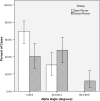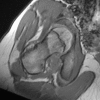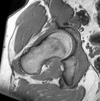The Otto Aufranc Award. On the etiology of the cam deformity: a cross-sectional pediatric MRI study
- PMID: 23604603
- PMCID: PMC3890176
- DOI: 10.1007/s11999-013-2990-y
The Otto Aufranc Award. On the etiology of the cam deformity: a cross-sectional pediatric MRI study
Abstract
Background: Femoroacetabular impingement (FAI) has been recognized as a common cause of hip pain as well as a cause of hip arthritis, yet despite this, little is known about the etiology of the cam morphology or possible risk factors associated with its development.
Questions/purposes: The purposes of our study were to determine when the cam morphology associated with FAI developed in a cross-sectional cohort study of pediatric patients pre- and postphyseal closure using MRI and whether increased activity level during the period of physeal closure is associated with an increased likelihood that the cam deformity will develop.
Methods: Alpha angles were measured at the 3 o'clock (anterior head-neck junction) and 1:30 (anterosuperior head-neck junction) positions in both hips with a cam deformity defined as an alpha angle ≥ 50.5° at the 3 o'clock position. Forty-four volunteers (88 hips) were studied: 23 with open physes (12 females, mean age 9.7 years; 11 males, age 11.7 years) and 21 with closed physes (five females, age 15.2 years; 16 males, age 16.2 years). Daily activity level using the validated Habitual Activity Estimation Scale was compared for patients in whom cam morphology did and did not develop.
Results: None of the 23 (0%) patients prephyseal closure had cam morphology, whereas three of 21 (14%, p = 0.02; all males) postclosure had at least one hip with cam morphology. Daily activity level was higher (p = 0.02) for patients with the cam morphology (7.1 hours versus 2.9 hours). Mean alpha angles at the 3 o'clock head-neck position were 38° (95% confidence interval [CI], 37.2°-39.1°) in the open physes group and 42° (95% CI, 40.16°-43.90°) in the closed physes group; at the 1:30 head-neck position, they were 45° (95% CI, 44.0°-46.4°) in the open physes group and 50° (47.9°-52.3°) in the closed physes group.
Conclusions: The fact that cam morphology was present exclusively in the closed physeal group strongly supports its development during the period of physeal closure with increased activity level as a possible risk factor.
Figures



References
-
- Anderson M, Green WT, Messner MB. Growth and predictions of growth in the lower extremities. J Bone Joint Surg Am. 1963;45:1–14. - PubMed
-
- Beaule PE, Zaragoza EJ, Motamedic K, Copelan N, Dorey J. Three-dimensional computed tomography of the hip in the assessment of femoro-acetabular impingement. J Orthop Res. 2005;23:1286–1292. - PubMed
-
- Dimeglio A. Growth in pediatric orthopaedics. J Pediatr Orthop. 2001;21:549–555. - PubMed
Publication types
MeSH terms
LinkOut - more resources
Full Text Sources
Other Literature Sources
Medical

